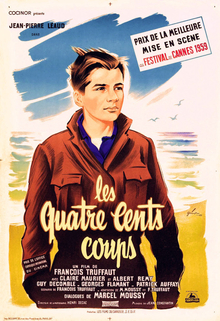Post 40- Analysing the micro elements in a scene from 'The 400 Blows'
Mise-en-scene:
Costume:
- In this scene from 'The 400 Blows,' Antoine Doinel is wearing a black coat, black trousers and a white shirt.
- At the beginning of the scene, he is playing football at school, where all of the other boys are wearing a black coat, black trousers and a white shirt, showing how this may be their uniform when they are playing football.
- By having all the characters in this scene wearing the same clothing it represents how Antoine belongs to something, yet as he is running away signifies how he wants to break away from it, perhaps as he wants to be his own person and break away from the connotations with being a young person as throughout the rest of the film he is labelled as a 'no good' boy who sets out to cause trouble.
Makeup:
- Neutral makeup is worn in this scene.
Props:
- In this scene, there are numerous road signs as Antoine is running away, perhaps being a representation of him getting further and further away.
- As well as this, the barbed wire which Antoine Doinel crawls under to escape could be a representation of the confinements that Antoine faced whilst still living there, people had misconceptions of him, therefore, restricting him to what he is able to do whilst living there.
- He has managed to find a way to escape, almost acting as a 'crack in the system'.
Lighting:
- Naturalistic lighting is used in this scene
Character expression/movement:
- In this scene, Antoine is running away from his life as he has now been labelled as an irresponsible boy in the eyes of his school and his parents. By having him running it emphasises his desperation to get away from the life he is living.
- At the end of the film, we can see the iconic moment when he looks directly into the camera which then leads to a freeze frame thus ending the film, this expression which he gives the camera could represent how he can no longer go any further as he has reached the ocean and has no way of crossing. As well as this, it could also present the idea that he is now thinking what he can do next in order to get across the ocean. Finally, this look that he gives the camera at the end could be an implication of him reaching his final goal, he's got as far away as he could have done, but as he is turning back he looks at the camera perhaps showing how he knows he has to go back, however, he's proved to himself that he can run away.
Setting:
- This scene begins at his school, however as he escapes we see different scenes, we see farmland, cottages, and roads. All showing the development of his escape as he's getting further and further away.
- The final setting is the beach, the place in which he stops running. The beach may have been chosen by the director, François Truffaut to show how can no longer go any further as he cannot cross the ocean, he's reached his limits.
Cinematography:
- In this scene, a Steadicam was used when he was running away to effectively show his speed and to allow the spectators to keep up with him as he runs, almost acting as if they are running alongside him.
- At the end of the scene, a close-up shot is used to emphasise Antoine's expression, perhaps being a representation of his disappointment that he can no longer get any further as he cannot cross the ocean.
- As well as this, when he first runs away a wide shot is used to show how far he has got, this could also be a representation of perspective and how small he is in comparison to the rest of the world, thus emphasising his age.
- When he gets to the beach a wide panning shot is used to show the scale of the beach, by having a pan shot it could represent how Antoine is admiring his view, he has run all this way to see it. However, this shot could also represent how he is looking for a way to run further but all that can be seen now is the ocean.
- Whip pan transition cuts were used to show his progression with his escape until he gets to the road where he runs down.
Editing:
- This scene is edited in a chronological order and the editing process of this scene shows the development of his journey, the shots used are longer than the conventional shot. For example when he is running no cuts are used to 'speed' up his journey, therefore making the spectators feel as though they're running with him.
Sound:
- At the start of the scene, spectators are able to hear the football team, thus implying the chaos of school which contrasts to the silence which he can hear once he's escaped.
- Once he has escaped out of school, birds can be heard, therefore implying that he has now entered the countryside and all of the previous sounds have been washed out. The birds tweeting signify the start of his road to escape. Whilst he's running these 'countryside' sounds can be heard implying that he is getting further away from the city.
- When he arrives at the beach, non-diegetic music begins to get filtered in slowly, creating the transition from diegetic sound and non-diegetic sound smoother. Once he gets to the beach traditional French music has been used, perhaps to represent his freedom.


Comments
Post a Comment